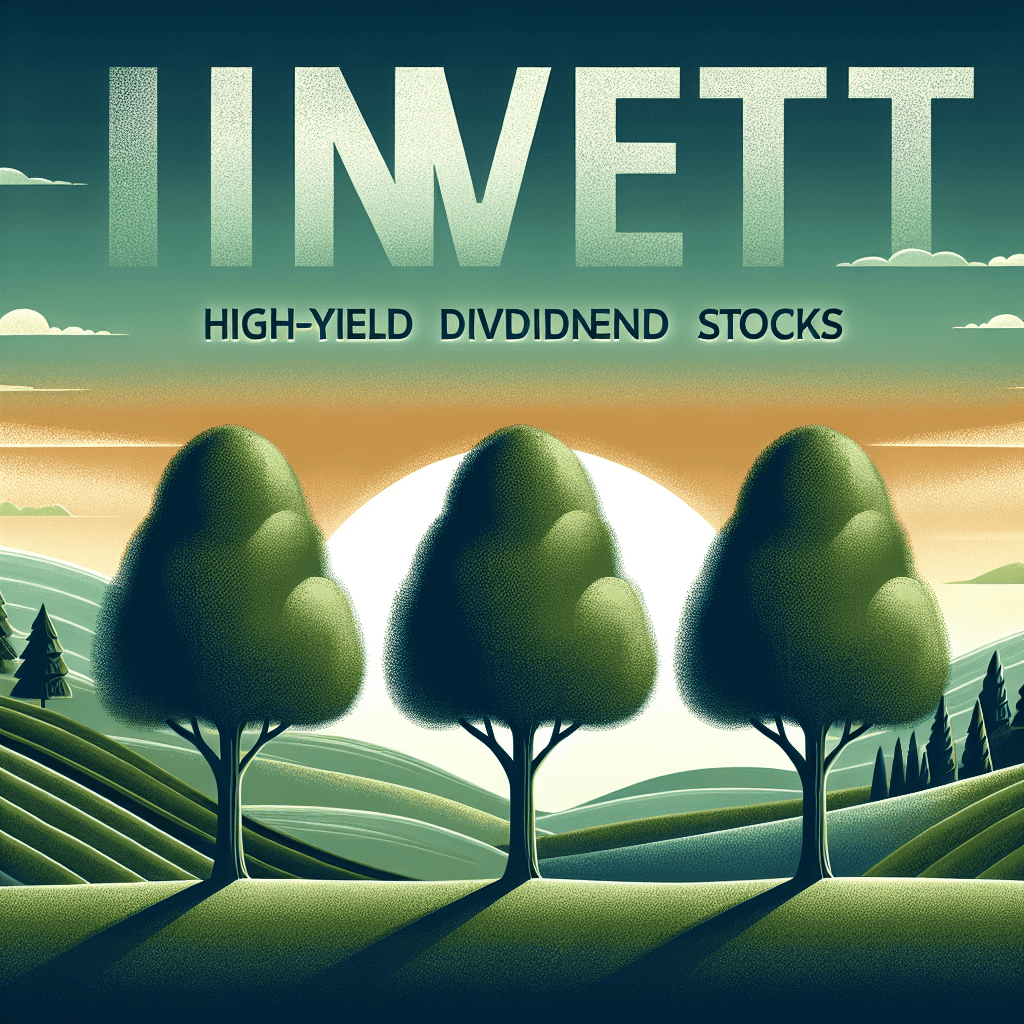“Secure Your Future: Invest in High-Yield Dividends for Lasting Peace of Mind.”
Introduction
Investing in high-yield dividend stocks can be a strategic move for those seeking both income and stability in their portfolios. These stocks not only provide regular income through dividends but also offer the potential for capital appreciation over time. In an unpredictable market environment, selecting the right dividend stocks can offer long-term peace of mind, ensuring a steady income stream and reducing overall portfolio volatility. This article highlights three high-yield dividend stocks that stand out for their robust financial health, consistent dividend payouts, and potential for sustainable growth, making them ideal candidates for investors looking to secure their financial future.
Understanding High-Yield Dividend Stocks: A Path to Financial Security
Investing in high-yield dividend stocks can be a prudent strategy for those seeking financial security and long-term peace of mind. These stocks offer the dual benefits of potential capital appreciation and regular income through dividends, making them an attractive option for investors who prioritize stability and consistent returns. As we delve into the world of high-yield dividend stocks, it is essential to understand their role in a diversified investment portfolio and how they can contribute to financial well-being.
High-yield dividend stocks are shares of companies that pay dividends at a higher rate compared to the average yield of the broader market. These dividends are typically distributed from the company’s profits, providing shareholders with a steady income stream. This characteristic makes them particularly appealing to retirees or those looking to supplement their income without selling their investments. Moreover, reinvesting dividends can compound returns over time, further enhancing the growth potential of one’s portfolio.
One of the primary reasons investors gravitate towards high-yield dividend stocks is their ability to provide a buffer against market volatility. In times of economic uncertainty or market downturns, these stocks tend to be less volatile than growth stocks, as the regular dividend payments can help offset declines in share prices. This stability is often attributed to the nature of the companies that issue high-yield dividends, which are typically well-established, financially sound businesses with a history of generating consistent cash flows.
Furthermore, high-yield dividend stocks can serve as a hedge against inflation. As the cost of living rises, the purchasing power of fixed-income investments, such as bonds, may erode. However, companies that consistently increase their dividend payouts can help investors maintain their purchasing power over time. This is particularly true for companies operating in sectors with strong pricing power, such as utilities, consumer staples, and healthcare, which can pass on increased costs to consumers without significantly affecting demand.
When selecting high-yield dividend stocks, it is crucial to consider the sustainability of the dividend payments. A high yield may be enticing, but it is essential to assess whether the company can maintain or grow its dividend over time. This involves analyzing the company’s payout ratio, which is the proportion of earnings paid out as dividends. A lower payout ratio suggests that the company retains a significant portion of its earnings for reinvestment or to weather economic downturns, thereby enhancing the sustainability of its dividend.
Additionally, investors should evaluate the company’s financial health, including its debt levels and cash flow generation. Companies with strong balance sheets and robust cash flows are better positioned to sustain their dividend payments, even in challenging economic environments. It is also advisable to diversify across different sectors to mitigate risks associated with industry-specific downturns.
In conclusion, high-yield dividend stocks can be a valuable component of a long-term investment strategy, offering both income and growth potential. By carefully selecting stocks with sustainable dividends and strong financial fundamentals, investors can achieve a sense of financial security and peace of mind. As with any investment, due diligence and a thorough understanding of the underlying companies are essential to maximizing the benefits of high-yield dividend stocks.
The Benefits of Long-Term Investment in Dividend Stocks
Investing in high-yield dividend stocks can be a prudent strategy for those seeking long-term financial stability and peace of mind. Dividend stocks, particularly those with a history of consistent payouts, offer investors a reliable income stream, which can be especially appealing in volatile market conditions. By focusing on high-yield dividend stocks, investors can potentially enjoy both capital appreciation and regular income, making them an attractive option for long-term investment portfolios.
One of the primary benefits of investing in dividend stocks is the potential for steady income. Unlike growth stocks, which reinvest profits to fuel expansion, dividend stocks distribute a portion of their earnings to shareholders. This distribution can provide a consistent cash flow, which is particularly beneficial for retirees or those looking to supplement their income. Moreover, companies that pay dividends often have strong fundamentals and a proven track record of profitability, which can offer investors a sense of security.
In addition to providing income, dividend stocks can also contribute to portfolio diversification. By including dividend-paying stocks from various sectors, investors can mitigate risk and reduce the impact of market volatility. This diversification is crucial for long-term investment success, as it helps to balance the portfolio and protect against sector-specific downturns. Furthermore, dividend stocks often belong to established companies with stable business models, which can provide a buffer against economic fluctuations.
Another advantage of investing in high-yield dividend stocks is the potential for capital appreciation. While the primary focus of dividend stocks is income generation, many of these stocks also experience price appreciation over time. This dual benefit of income and growth can enhance the overall return on investment, making dividend stocks a compelling choice for long-term investors. Additionally, reinvesting dividends through a dividend reinvestment plan (DRIP) can further compound returns, as it allows investors to purchase additional shares without incurring transaction fees.
Tax efficiency is another consideration when investing in dividend stocks. In many jurisdictions, qualified dividends are taxed at a lower rate than ordinary income, which can result in significant tax savings for investors. This tax advantage can enhance the after-tax return on investment, making dividend stocks an even more attractive option for long-term wealth accumulation.
Moreover, investing in high-yield dividend stocks can instill a sense of discipline and patience in investors. The focus on long-term income generation encourages investors to adopt a buy-and-hold strategy, which can reduce the temptation to engage in short-term trading and market timing. This disciplined approach can lead to more stable investment outcomes and help investors achieve their financial goals over time.
In conclusion, high-yield dividend stocks offer a multitude of benefits for long-term investors. From providing a steady income stream and portfolio diversification to offering potential capital appreciation and tax efficiency, these stocks can be a valuable addition to any investment strategy. By focusing on companies with a history of consistent dividend payments and strong fundamentals, investors can enjoy the peace of mind that comes with a well-constructed, long-term investment portfolio. As such, incorporating high-yield dividend stocks into one’s investment strategy can be a wise decision for those seeking financial stability and growth over the long haul.
Analyzing the Top 3 High-Yield Dividend Stocks for 2023
In the ever-evolving landscape of financial markets, investors are constantly on the lookout for opportunities that promise stability and consistent returns. High-yield dividend stocks have long been a favored choice for those seeking to balance risk with reward, offering not only the potential for capital appreciation but also a steady stream of income. As we delve into 2023, three high-yield dividend stocks stand out as particularly promising for long-term investors: Johnson & Johnson, Realty Income Corporation, and AT&T Inc.
To begin with, Johnson & Johnson, a stalwart in the healthcare sector, continues to be a reliable choice for dividend-seeking investors. With a diversified portfolio that spans pharmaceuticals, medical devices, and consumer health products, Johnson & Johnson has demonstrated resilience in the face of economic fluctuations. The company’s robust financial health is underscored by its consistent dividend payments, which have been steadily increasing for over five decades. This track record of dividend growth, coupled with its strong market position and innovative pipeline, makes Johnson & Johnson a compelling option for those looking to secure long-term peace of mind.
Transitioning to the real estate sector, Realty Income Corporation, often referred to as “The Monthly Dividend Company,” offers a unique proposition for income-focused investors. Specializing in commercial real estate, Realty Income boasts a diverse portfolio of properties leased to high-quality tenants across various industries. The company’s commitment to paying monthly dividends, a rarity in the market, has earned it a loyal following among investors. Realty Income’s disciplined acquisition strategy and focus on long-term leases provide a stable revenue stream, which in turn supports its ability to deliver reliable dividend payments. As the demand for commercial real estate remains robust, Realty Income is well-positioned to continue its tradition of rewarding shareholders.
Finally, AT&T Inc., a major player in the telecommunications industry, presents an intriguing opportunity for dividend investors. Despite facing challenges in recent years, AT&T has taken significant steps to streamline its operations and focus on its core business areas. The company’s strategic divestitures and investments in 5G technology are expected to enhance its competitive edge and drive future growth. AT&T’s commitment to maintaining a high dividend yield, even amidst industry headwinds, underscores its dedication to returning value to shareholders. As the world becomes increasingly connected, AT&T’s expansive network and customer base provide a solid foundation for sustained dividend payments.
In conclusion, while the stock market is inherently unpredictable, investing in high-yield dividend stocks like Johnson & Johnson, Realty Income Corporation, and AT&T Inc. can offer a measure of stability and peace of mind. These companies, each a leader in their respective sectors, have demonstrated a commitment to rewarding shareholders through consistent dividend payments. By carefully analyzing their financial health, market position, and growth prospects, investors can make informed decisions that align with their long-term financial goals. As we navigate the complexities of 2023 and beyond, these high-yield dividend stocks stand out as prudent choices for those seeking to build a resilient investment portfolio.
How Dividend Stocks Can Provide Peace of Mind in Volatile Markets

In the ever-fluctuating landscape of financial markets, investors often seek stability and predictability to safeguard their portfolios against volatility. One effective strategy to achieve this is by investing in high-yield dividend stocks. These stocks not only offer the potential for capital appreciation but also provide a steady stream of income, which can be particularly reassuring during turbulent times. By focusing on companies with a strong track record of dividend payments, investors can enjoy a sense of security and long-term peace of mind.
To begin with, high-yield dividend stocks are typically associated with well-established companies that have a history of generating consistent profits. These companies often operate in mature industries where growth may be slower, but their ability to generate cash flow remains robust. As a result, they can afford to distribute a significant portion of their earnings to shareholders in the form of dividends. This regular income can act as a buffer against market downturns, offering investors a reliable source of returns even when stock prices are under pressure.
Moreover, investing in dividend-paying stocks can also provide a hedge against inflation. As the cost of living rises, the purchasing power of money diminishes. However, companies that consistently increase their dividend payouts can help investors maintain their purchasing power over time. This is because dividend growth often outpaces inflation, ensuring that the real value of the income received by investors does not erode. Consequently, high-yield dividend stocks can serve as a valuable component of a diversified investment portfolio, offering both income and growth potential.
In addition to providing income and inflation protection, high-yield dividend stocks can also enhance portfolio stability. During periods of market volatility, stocks that pay dividends tend to be less volatile than their non-dividend-paying counterparts. This is because the regular income from dividends can help cushion the impact of falling stock prices, reducing overall portfolio risk. Furthermore, companies that pay dividends are often perceived as financially stable, which can attract more conservative investors and contribute to price stability.
Transitioning to specific examples, consider investing in companies like Johnson & Johnson, Procter & Gamble, and Coca-Cola. These firms have long been recognized for their commitment to returning value to shareholders through dividends. Johnson & Johnson, for instance, has a diversified business model spanning pharmaceuticals, medical devices, and consumer health products, which provides a stable revenue base. Similarly, Procter & Gamble’s extensive portfolio of consumer goods ensures consistent demand, while Coca-Cola’s global brand recognition and distribution network support its ability to generate steady cash flow.
Furthermore, these companies have demonstrated resilience in the face of economic challenges, maintaining or even increasing their dividend payouts during downturns. This track record of reliability can instill confidence in investors, knowing that their investments are backed by companies with strong fundamentals and a commitment to shareholder returns. By including such high-yield dividend stocks in their portfolios, investors can achieve a balanced approach that combines income generation with the potential for capital appreciation.
In conclusion, high-yield dividend stocks offer a compelling investment opportunity for those seeking long-term peace of mind in volatile markets. By providing a steady income stream, protection against inflation, and enhanced portfolio stability, these stocks can serve as a cornerstone of a well-rounded investment strategy. As investors navigate the complexities of the financial markets, focusing on companies with a proven history of dividend payments can offer a sense of security and confidence in their financial future.
Strategies for Selecting High-Yield Dividend Stocks
When considering investment strategies that prioritize both income and stability, high-yield dividend stocks often emerge as a compelling choice. These stocks not only provide a steady stream of income through dividends but also offer the potential for capital appreciation over time. However, selecting the right high-yield dividend stocks requires a careful evaluation of several key factors to ensure long-term peace of mind. By focusing on companies with strong financial health, a history of consistent dividend payments, and a sustainable payout ratio, investors can build a robust portfolio that withstands market volatility.
To begin with, financial health is a critical criterion when selecting high-yield dividend stocks. Companies with strong balance sheets, low debt levels, and healthy cash flows are better positioned to maintain and grow their dividend payments. This financial stability acts as a buffer during economic downturns, ensuring that the company can continue to reward its shareholders even in challenging times. For instance, firms in sectors such as utilities and consumer staples often exhibit these characteristics, as they provide essential services and products that remain in demand regardless of economic conditions.
In addition to financial health, a history of consistent dividend payments is another vital factor to consider. Companies that have demonstrated a commitment to returning capital to shareholders over many years are generally more reliable. This track record indicates a management team that prioritizes shareholder value and has the operational strength to support regular dividend distributions. Moreover, companies that have consistently increased their dividends over time, often referred to as “dividend aristocrats,” can be particularly attractive. These firms not only provide a reliable income stream but also offer the potential for income growth, which can help offset the effects of inflation.
Furthermore, evaluating a company’s payout ratio is essential in assessing the sustainability of its dividend payments. The payout ratio, which is the proportion of earnings paid out as dividends, provides insight into how much of a company’s profits are being returned to shareholders versus being reinvested in the business. A moderate payout ratio suggests that a company is balancing its dividend payments with the need to invest in future growth. Conversely, a very high payout ratio may indicate that a company is overextending itself, potentially jeopardizing its ability to maintain dividends in the future. Therefore, investors should seek companies with payout ratios that reflect a prudent approach to capital allocation.
Transitioning from these selection criteria to specific stock recommendations, investors might consider companies like Johnson & Johnson, Procter & Gamble, and Verizon Communications. Johnson & Johnson, with its diversified portfolio of healthcare products, has a strong financial foundation and a long history of dividend increases. Procter & Gamble, a leader in consumer goods, offers stability and consistent dividend growth, supported by its global brand recognition and operational efficiency. Verizon Communications, a major player in the telecommunications industry, provides an attractive dividend yield backed by its robust cash flow and essential service offerings.
In conclusion, investing in high-yield dividend stocks can be a rewarding strategy for those seeking long-term financial security. By focusing on companies with strong financial health, a proven track record of dividend payments, and sustainable payout ratios, investors can build a portfolio that not only generates income but also offers the potential for growth. As always, thorough research and due diligence are paramount to making informed investment decisions that align with one’s financial goals and risk tolerance.
The Role of Dividend Reinvestment in Building Wealth
Dividend reinvestment plays a pivotal role in building wealth over the long term, offering investors a powerful mechanism to enhance their financial portfolios. By reinvesting dividends, investors can capitalize on the compounding effect, which significantly amplifies returns over time. This strategy is particularly effective when applied to high-yield dividend stocks, which not only provide regular income but also offer the potential for substantial capital appreciation. Among the myriad of investment options available, three high-yield dividend stocks stand out as particularly promising for those seeking long-term peace of mind: Johnson & Johnson, Procter & Gamble, and Coca-Cola.
Johnson & Johnson, a stalwart in the healthcare sector, has consistently demonstrated its ability to generate robust cash flows, which in turn support its generous dividend payouts. The company’s diversified product portfolio, spanning pharmaceuticals, medical devices, and consumer health products, provides a stable revenue stream that is less susceptible to economic downturns. This stability is further bolstered by Johnson & Johnson’s commitment to innovation and its strong pipeline of new products. By reinvesting dividends from Johnson & Johnson, investors can benefit from the company’s growth while enjoying the security of a reliable income source.
Similarly, Procter & Gamble, a leader in the consumer goods industry, offers a compelling case for dividend reinvestment. Known for its extensive range of trusted brands, Procter & Gamble has a long history of delivering consistent financial performance. The company’s strategic focus on innovation and efficiency has enabled it to maintain competitive margins and sustain its dividend growth. For investors, reinvesting dividends in Procter & Gamble not only enhances their stake in a well-managed company but also aligns their interests with a business that prioritizes shareholder returns. This alignment is crucial for those seeking to build wealth steadily over time.
Coca-Cola, a global beverage giant, rounds out the trio of high-yield dividend stocks worthy of consideration. With its iconic brand and expansive distribution network, Coca-Cola has established a formidable presence in markets worldwide. The company’s ability to adapt to changing consumer preferences, coupled with its strategic investments in product diversification, ensures its continued relevance and profitability. By reinvesting dividends from Coca-Cola, investors can tap into the company’s enduring appeal and growth potential. This approach not only enhances portfolio value but also provides a hedge against market volatility, given Coca-Cola’s resilience in various economic climates.
In conclusion, the role of dividend reinvestment in building wealth cannot be overstated. By choosing high-yield dividend stocks like Johnson & Johnson, Procter & Gamble, and Coca-Cola, investors can harness the power of compounding to achieve long-term financial goals. These companies, with their strong market positions and commitment to shareholder returns, offer a reliable foundation for wealth accumulation. As investors reinvest dividends, they effectively increase their ownership in these businesses, thereby participating in their growth and success. This strategy not only provides a steady income stream but also fosters a sense of financial security, allowing investors to navigate the complexities of the market with confidence. Ultimately, the disciplined practice of dividend reinvestment, particularly in high-quality stocks, serves as a cornerstone for building enduring wealth and achieving long-term peace of mind.
Comparing High-Yield Dividend Stocks to Other Investment Options
When considering investment options, high-yield dividend stocks often stand out as a compelling choice for those seeking both income and long-term growth. Unlike other investment vehicles such as bonds or savings accounts, which typically offer fixed returns, dividend stocks provide the dual benefit of potential capital appreciation and regular income through dividends. This combination can be particularly appealing in a low-interest-rate environment where traditional fixed-income investments may not generate sufficient returns to meet investors’ needs.
To understand why high-yield dividend stocks can be a superior choice, it is essential to compare them with other popular investment options. For instance, growth stocks, while offering the potential for significant capital gains, often do not pay dividends. This means that investors relying solely on growth stocks must depend on the appreciation of stock prices to realize returns, which can be volatile and unpredictable. In contrast, high-yield dividend stocks provide a steady income stream, which can be reinvested to compound returns over time or used to meet immediate financial needs.
Moreover, when compared to real estate investments, high-yield dividend stocks offer greater liquidity and lower transaction costs. Real estate can be an attractive investment due to its potential for rental income and appreciation. However, it often requires substantial capital, ongoing maintenance, and management efforts. Additionally, real estate transactions can be time-consuming and costly. On the other hand, dividend stocks can be bought and sold with relative ease, allowing investors to adjust their portfolios quickly in response to market changes.
Furthermore, high-yield dividend stocks can serve as a hedge against inflation, a feature that is not as pronounced in fixed-income investments like bonds. While bonds provide regular interest payments, their fixed nature means that they may lose purchasing power over time as inflation rises. Dividend-paying companies, particularly those with a history of increasing their payouts, can offer a growing income stream that helps preserve purchasing power. This makes them an attractive option for investors looking to maintain their standard of living in the face of rising prices.
In addition to these advantages, high-yield dividend stocks often belong to well-established companies with strong financial foundations. These companies typically have a track record of profitability and a commitment to returning capital to shareholders, which can provide a sense of security and stability. This is particularly important for risk-averse investors who prioritize capital preservation alongside income generation.
While no investment is without risk, high-yield dividend stocks offer a balanced approach that can appeal to a wide range of investors. By providing both income and the potential for capital appreciation, they can play a crucial role in a diversified investment portfolio. As with any investment decision, it is important for investors to conduct thorough research and consider their individual financial goals and risk tolerance. However, for those seeking long-term peace of mind, high-yield dividend stocks represent a compelling option that can deliver consistent returns while mitigating some of the uncertainties inherent in other investment choices.
Q&A
1. **What is a high-yield dividend stock?**
– A high-yield dividend stock is a stock that offers a higher-than-average dividend yield, providing investors with regular income in addition to potential capital appreciation.
2. **Why invest in high-yield dividend stocks for long-term peace of mind?**
– High-yield dividend stocks can provide a steady income stream, reduce portfolio volatility, and offer potential for capital growth, contributing to financial stability and peace of mind over the long term.
3. **What are some characteristics of reliable high-yield dividend stocks?**
– Reliable high-yield dividend stocks typically have a strong track record of dividend payments, stable cash flows, a sustainable payout ratio, and a solid business model.
4. **Name one high-yield dividend stock recommended for long-term investment.**
– Realty Income Corporation (O) is often recommended due to its consistent monthly dividends and strong portfolio of commercial properties.
5. **What is the significance of a sustainable payout ratio in dividend stocks?**
– A sustainable payout ratio indicates that a company can maintain its dividend payments without compromising its financial health, ensuring long-term reliability for investors.
6. **How do economic conditions affect high-yield dividend stocks?**
– Economic conditions can impact the performance of high-yield dividend stocks, as interest rates, inflation, and market volatility can influence dividend yields and stock prices.
7. **What is a potential risk of investing in high-yield dividend stocks?**
– A potential risk is the possibility of dividend cuts if a company faces financial difficulties, which can lead to reduced income for investors and a decline in stock value.
Conclusion
Investing in high-yield dividend stocks can provide a reliable income stream and potential for capital appreciation, offering long-term peace of mind for investors. The three stocks highlighted in this context likely possess strong financial fundamentals, a history of consistent dividend payments, and the potential for growth, making them attractive options for those seeking stability and income in their investment portfolios. By focusing on companies with sustainable dividend yields and robust business models, investors can mitigate risks and enhance their financial security over the long term.





